The Taj Mahal
It was built in 1632 and completed in 1653.The origin of the name "Taj Mahal" is not clear. Court histories from Shah Jehan's reign only call it the rauza (tomb) of Mumtaz Mahal. It is generally believed that "Taj Mahal" (usually translated as either "Crown Palace" or "Crown of the Palace") is an abbreviated version of her name, Mumtaz Mahal.
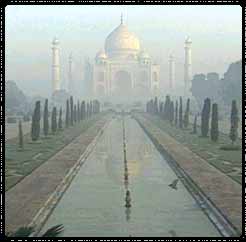 The construction of this marble masterpiece is credited to the Mughal emperor Shah Jahan who erected this mausoleum in the memory of his beloved wife, Arjumand Bano Begum, popularly known as Mumtaz Mahal, who died in AH 1040 (AD 1630). Her last wish to her husband was "to build a tomb in her memory such as the world had never seen before". Thus emperor Shah Jahan set about building this fairytale like marvel.
The construction of this marble masterpiece is credited to the Mughal emperor Shah Jahan who erected this mausoleum in the memory of his beloved wife, Arjumand Bano Begum, popularly known as Mumtaz Mahal, who died in AH 1040 (AD 1630). Her last wish to her husband was "to build a tomb in her memory such as the world had never seen before". Thus emperor Shah Jahan set about building this fairytale like marvel.The construction of Taj Mahal was started in AD 1631 and completed at the end of 1648 AD. For seventeen years, twenty thousand workmen are said to be employed on it daily, for their accommodation a small town, named after the deceased empress-'Mumtazabad, now known as Taj Ganj, was built adjacent to it. Amanat Khan Shirazi was the calligrapher of Taj Mahal, his name occurs at the end of an inscription on one of the gates of the Taj. Poet Ghyasuddin had designed the verses on the tombstone, while Ismail Khan Afridi of Turkey was the dome maker. Muhammad Hanif was the superintendent of Masons. The designer of Taj Mahal was Ustad Ahmad Lahauri. The material was brought in from all over India and central Asia and it took a fleet of 1000 elephants to transport it to the site. The central dome is 187 feet high at the centre. Red sandstone was brought from Fatehpur Sikri, Jasper from Punjab, Jade and Crystal from China, Turquoise from Tibet, Lapis Lazuli and Sapphire from Sri Lanka, Coal and Cornelian from Arabia and diamonds from Panna. In all 28 kind of rare, semi precious and precious stones were used for inlay work in the Taj Mahal. The chief building material, the white marble was brought from the quarries of Makrana, in distt. Nagaur, Rajasthan.
histroy of taj mahal
The origin of the name "Taj Mahal" is not clear. Court histories from Shah Jehan's reign only call it the rauza (tomb) of Mumtaz Mahal. It is generally believed that "Taj Mahal" (usually translated as either "Crown Palace" or "Crown of the Palace") is an abbreviated version of her name, Mumtaz Mahal.
The construction of this marble masterpiece is credited to the Mughal emperor Shah Jahan who erected this mausoleum in the memory of his beloved wife, Arjumand Bano Begum, popularly known as Mumtaz Mahal, who died in AH 1040 (AD 1630). Her last wish to her husband was "to build a tomb in her memory such as the world had never seen before". Thus emperor Shah Jahan set about building this fairytale like marvel.
The construction of Taj Mahal was started in AD 1631 and completed at the end of 1648 AD. For seventeen years, twenty thousand workmen are said to be employed on it daily, for their accommodation a small town, named after the deceased empress-'Mumtazabad, now known as Taj Ganj, was built adjacent to it. Amanat Khan Shirazi was the calligrapher of Taj Mahal, his name occurs at the end of an inscription on one of the gates of the Taj. Poet Ghyasuddin had designed the verses on the tombstone, while Ismail Khan Afridi of Turkey was the dome maker. Muhammad Hanif was the superintendent of Masons. The designer of Taj Mahal was Ustad Ahmad Lahauri. The material was brought in from all over India and central Asia and it took a fleet of 1000 elephants to transport it to the site. The central dome is 187 feet high at the centre. Red sandstone was brought from Fatehpur Sikri, Jasper from Punjab, Jade and Crystal from China, Turquoise from Tibet, Lapis Lazuli and Sapphire from Sri Lanka, Coal and Cornelian from Arabia and diamonds from Panna. In all 28 kind of rare, semi precious and precious stones were used for inlay work in the Taj Mahal. The chief building material, the white marble was brought from the quarries of Makrana, in distt. Nagaur, Rajasthan.
architectural style
It is mugal architectural styleThe Gardens
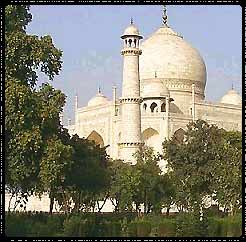 A green carpet of garden runs from the main gateway to the foot of the Taj. In essence, it is a Persian garden, a from born and nursed to maturity in the desert flat of Persia. Such gardens were introduced to India by Baber, the first mughal emperor, who also brought with him the Persian infatuation with flowers and fruit, birds and leaves, symmetry and delicacy. Unlike other Oriental gardens - especially those of the Japanese, who learned to accentuate existing resources rather than formalise them - the Persian garden was artificially contrived, unbashedly man-made, based on geometric arrangements of nature without any attempt at a "natural" look.
A green carpet of garden runs from the main gateway to the foot of the Taj. In essence, it is a Persian garden, a from born and nursed to maturity in the desert flat of Persia. Such gardens were introduced to India by Baber, the first mughal emperor, who also brought with him the Persian infatuation with flowers and fruit, birds and leaves, symmetry and delicacy. Unlike other Oriental gardens - especially those of the Japanese, who learned to accentuate existing resources rather than formalise them - the Persian garden was artificially contrived, unbashedly man-made, based on geometric arrangements of nature without any attempt at a "natural" look. Like Persian gardeners, landscape artists at the Taj attempted to translate the perfection of heaven into terrestrial terms by following certain formulas. In Islam, four is the holiest of all numbers - most arrangements of the Taj are based on that number or its multiples - and the gardens were thus laid out in the quadrate plan. Two marble canals studded with fountains and lined with cypress trees (symbolising death) cross in the centre of the garden dividing it into four equal squares. The mausoleum, instead of occupying the central point (like most mughal mausoleums), stands majestically at the north end just above the river. Each of the four quarters of the garden have again been sub-divided into sixteen flower beds by stone-paved raised pathways. At the centre of the garden, halfway between the tomb and the gateway, stands a raised marble lotus-tank with a cusped and trefoiled border. The tank has been arranged to perfectly reflect the Taj in its waters.
A clear, unobstructed view of the mausoleum is available from any spot in the garden. Fountains and solemn rows of cypress trees only adorn the north-south water canal, lest the attention of the viewer would be diverted to the sides !! This shows how carefully the aesthetic effect of the water devices and the garden were calculated. The deep green cypress trees with their slender rising shapes and curving topmost crests are mirrored in the water while between their dark reflections shines the beauty of the immortal Taj.
The Water Devices
The architect who was fully aware of the unaesthetic appearance of the grotesque pur-ramps and crude conduits, designed a clever system to procure water for the Taj through underground pipes.
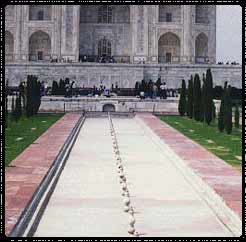 Water was drawn from the river by a series of purs (manual system of drawing water from a water body using a rope and bucket pulled by bullocks) and was brought through a broad water channel into an oblong storage tank of great dimensions. It was again raised by a series of thirteen purs worked by bullocks. Except for the ramps, the other features of the whole water system have survived. An over-head water-channel supported on massive arches carried water into another storage tank of still greater dimensions. Water was finally raised by means of fourteen purs and passed into a channel which filled three supply tanks, the last of which had pipe mouths in its eastern wall. The pipes descended below and after travelling underground crossed into the Taj enclosure. One pipe line runs directly towards the mosque to supply the fountains in the tanks on the red sandstone plinth below the marble structure. Copper pipes were used for separate series of fountains in the north-south canal, lotus pond and the canal around it.
Water was drawn from the river by a series of purs (manual system of drawing water from a water body using a rope and bucket pulled by bullocks) and was brought through a broad water channel into an oblong storage tank of great dimensions. It was again raised by a series of thirteen purs worked by bullocks. Except for the ramps, the other features of the whole water system have survived. An over-head water-channel supported on massive arches carried water into another storage tank of still greater dimensions. Water was finally raised by means of fourteen purs and passed into a channel which filled three supply tanks, the last of which had pipe mouths in its eastern wall. The pipes descended below and after travelling underground crossed into the Taj enclosure. One pipe line runs directly towards the mosque to supply the fountains in the tanks on the red sandstone plinth below the marble structure. Copper pipes were used for separate series of fountains in the north-south canal, lotus pond and the canal around it.An ingenious method was devised to ensure uniform and undiminished water pressure in the fountains, irrespective of the distance and the outflow of water. The fountain pipes were not connected directly with the copper pipes feeding them as this would have resulted in a gradual decrease in the volume and pressure of the water. Instead, a copper pot has been provided under each fountain pipe - which was thus connected to with the water supply only through the pot. Water first fills the pot and then only rises simultaneously in the fountains. The fountains are thus controlled by pressure in the pots and not pressure in the main pipe. As the pressure in the pots is uniformly distributed all the time, it ensures equal supply of water at the same rate in all the fountains. It is really creditable that the planner spared no efforts - belonging to art, architecture and engineering - to create a perfect production without the slightest weakness, architectural or aesthetic.The main supply of the water was however obtained through earthenware pipes. One such main was discovered under the bed of the western canal. The pipe is 9" in diameter and has been embedded in masonry at a depth of 5 feet below the level of the paved walk. Evidently, the mughal water expert was a master of his art and successfully worked out the levels in relation to the volume of water to ensure its unobstructed supply for centuries. He anticipated no repair work and therefore made no provision for it; hence the extraordinary depth at which the pipe was sunk.
The garden is irrigated by the overflowing of canals. The north-south canal has inlets of water through fountains. The east-west received its water through an interconnection with the north-south canal. Thus the quarters near the canals received an adequate supply of water and could be used for growing flower-plants which would not obscure the general view, while the distant quarters got a smaller supply of water and were suitable only for tall trees .
It's water devise.
The Gardens A green carpet of garden runs from the main gateway to the foot of the Taj. In essence, it is a Persian garden, a from born and nursed to maturity in the desert flat of Persia. Such gardens were introduced to India by Baber, the first mughal emperor, who also brought with him the Persian infatuation with flowers and fruit, birds and leaves, symmetry and delicacy. Unlike other Oriental gardens - especially those of the Japanese, who learned to accentuate existing resources rather than formalise them - the Persian garden was artificially contrived, unbashedly man-made, based on geometric arrangements of nature without any attempt at a "natural" look.
A green carpet of garden runs from the main gateway to the foot of the Taj. In essence, it is a Persian garden, a from born and nursed to maturity in the desert flat of Persia. Such gardens were introduced to India by Baber, the first mughal emperor, who also brought with him the Persian infatuation with flowers and fruit, birds and leaves, symmetry and delicacy. Unlike other Oriental gardens - especially those of the Japanese, who learned to accentuate existing resources rather than formalise them - the Persian garden was artificially contrived, unbashedly man-made, based on geometric arrangements of nature without any attempt at a "natural" look.
Like Persian gardeners, landscape artists at the Taj attempted to translate the perfection of heaven into terrestrial terms by following certain formulas. In Islam, four is the holiest of all numbers - most arrangements of the Taj are based on that number or its multiples - and the gardens were thus laid out in the quadrate plan. Two marble canals studded with fountains and lined with cypress trees (symbolising death) cross in the centre of the garden dividing it into four equal squares. The mausoleum, instead of occupying the central point (like most mughal mausoleums), stands majestically at the north end just above the river. Each of the four quarters of the garden have again been sub-divided into sixteen flower beds by stone-paved raised pathways. At the centre of the garden, halfway between the tomb and the gateway, stands a raised marble lotus-tank with a cusped and trefoiled border. The tank has been arranged to perfectly reflect the Taj in its waters.
A clear, unobstructed view of the mausoleum is available from any spot in the garden. Fountains and solemn rows of cypress trees only adorn the north-south water canal, lest the attention of the viewer would be diverted to the sides !! This shows how carefully the aesthetic effect of the water devices and the garden were calculated. The deep green cypress trees with their slender rising shapes and curving topmost crests are mirrored in the water while between their dark reflections shines the beauty of the immortal Taj.
The Water Devices
The architect who was fully aware of the unaesthetic appearance of the grotesque pur-ramps and crude conduits, designed a clever system to procure water for the Taj through underground pipes.
 Water was drawn from the river by a series of purs (manual system of drawing water from a water body using a rope and bucket pulled by bullocks) and was brought through a broad water channel into an oblong storage tank of great dimensions. It was again raised by a series of thirteen purs worked by bullocks. Except for the ramps, the other features of the whole water system have survived. An over-head water-channel supported on massive arches carried water into another storage tank of still greater dimensions. Water was finally raised by means of fourteen purs and passed into a channel which filled three supply tanks, the last of which had pipe mouths in its eastern wall. The pipes descended below and after travelling underground crossed into the Taj enclosure. One pipe line runs directly towards the mosque to supply the fountains in the tanks on the red sandstone plinth below the marble structure. Copper pipes were used for separate series of fountains in the north-south canal, lotus pond and the canal around it.
Water was drawn from the river by a series of purs (manual system of drawing water from a water body using a rope and bucket pulled by bullocks) and was brought through a broad water channel into an oblong storage tank of great dimensions. It was again raised by a series of thirteen purs worked by bullocks. Except for the ramps, the other features of the whole water system have survived. An over-head water-channel supported on massive arches carried water into another storage tank of still greater dimensions. Water was finally raised by means of fourteen purs and passed into a channel which filled three supply tanks, the last of which had pipe mouths in its eastern wall. The pipes descended below and after travelling underground crossed into the Taj enclosure. One pipe line runs directly towards the mosque to supply the fountains in the tanks on the red sandstone plinth below the marble structure. Copper pipes were used for separate series of fountains in the north-south canal, lotus pond and the canal around it.
An ingenious method was devised to ensure uniform and undiminished water pressure in the fountains, irrespective of the distance and the outflow of water. The fountain pipes were not connected directly with the copper pipes feeding them as this would have resulted in a gradual decrease in the volume and pressure of the water. Instead, a copper pot has been provided under each fountain pipe - which was thus connected to with the water supply only through the pot. Water first fills the pot and then only rises simultaneously in the fountains. The fountains are thus controlled by pressure in the pots and not pressure in the main pipe. As the pressure in the pots is uniformly distributed all the time, it ensures equal supply of water at the same rate in all the fountains. It is really creditable that the planner spared no efforts - belonging to art, architecture and engineering - to create a perfect production without the slightest weakness, architectural or aesthetic.The main supply of the water was however obtained through earthenware pipes. One such main was discovered under the bed of the western canal. The pipe is 9" in diameter and has been embedded in masonry at a depth of 5 feet below the level of the paved walk. Evidently, the mughal water expert was a master of his art and successfully worked out the levels in relation to the volume of water to ensure its unobstructed supply for centuries. He anticipated no repair work and therefore made no provision for it; hence the extraordinary depth at which the pipe was sunk.
The garden is irrigated by the overflowing of canals. The north-south canal has inlets of water through fountains. The east-west received its water through an interconnection with the north-south canal. Thus the quarters near the canals received an adequate supply of water and could be used for growing flower-plants which would not obscure the general view, while the distant quarters got a smaller supply of water and were suitable only for tall trees .
 A green carpet of garden runs from the main gateway to the foot of the Taj. In essence, it is a Persian garden, a from born and nursed to maturity in the desert flat of Persia. Such gardens were introduced to India by Baber, the first mughal emperor, who also brought with him the Persian infatuation with flowers and fruit, birds and leaves, symmetry and delicacy. Unlike other Oriental gardens - especially those of the Japanese, who learned to accentuate existing resources rather than formalise them - the Persian garden was artificially contrived, unbashedly man-made, based on geometric arrangements of nature without any attempt at a "natural" look.
A green carpet of garden runs from the main gateway to the foot of the Taj. In essence, it is a Persian garden, a from born and nursed to maturity in the desert flat of Persia. Such gardens were introduced to India by Baber, the first mughal emperor, who also brought with him the Persian infatuation with flowers and fruit, birds and leaves, symmetry and delicacy. Unlike other Oriental gardens - especially those of the Japanese, who learned to accentuate existing resources rather than formalise them - the Persian garden was artificially contrived, unbashedly man-made, based on geometric arrangements of nature without any attempt at a "natural" look. Like Persian gardeners, landscape artists at the Taj attempted to translate the perfection of heaven into terrestrial terms by following certain formulas. In Islam, four is the holiest of all numbers - most arrangements of the Taj are based on that number or its multiples - and the gardens were thus laid out in the quadrate plan. Two marble canals studded with fountains and lined with cypress trees (symbolising death) cross in the centre of the garden dividing it into four equal squares. The mausoleum, instead of occupying the central point (like most mughal mausoleums), stands majestically at the north end just above the river. Each of the four quarters of the garden have again been sub-divided into sixteen flower beds by stone-paved raised pathways. At the centre of the garden, halfway between the tomb and the gateway, stands a raised marble lotus-tank with a cusped and trefoiled border. The tank has been arranged to perfectly reflect the Taj in its waters.
A clear, unobstructed view of the mausoleum is available from any spot in the garden. Fountains and solemn rows of cypress trees only adorn the north-south water canal, lest the attention of the viewer would be diverted to the sides !! This shows how carefully the aesthetic effect of the water devices and the garden were calculated. The deep green cypress trees with their slender rising shapes and curving topmost crests are mirrored in the water while between their dark reflections shines the beauty of the immortal Taj.
The Water Devices
The architect who was fully aware of the unaesthetic appearance of the grotesque pur-ramps and crude conduits, designed a clever system to procure water for the Taj through underground pipes.
 Water was drawn from the river by a series of purs (manual system of drawing water from a water body using a rope and bucket pulled by bullocks) and was brought through a broad water channel into an oblong storage tank of great dimensions. It was again raised by a series of thirteen purs worked by bullocks. Except for the ramps, the other features of the whole water system have survived. An over-head water-channel supported on massive arches carried water into another storage tank of still greater dimensions. Water was finally raised by means of fourteen purs and passed into a channel which filled three supply tanks, the last of which had pipe mouths in its eastern wall. The pipes descended below and after travelling underground crossed into the Taj enclosure. One pipe line runs directly towards the mosque to supply the fountains in the tanks on the red sandstone plinth below the marble structure. Copper pipes were used for separate series of fountains in the north-south canal, lotus pond and the canal around it.
Water was drawn from the river by a series of purs (manual system of drawing water from a water body using a rope and bucket pulled by bullocks) and was brought through a broad water channel into an oblong storage tank of great dimensions. It was again raised by a series of thirteen purs worked by bullocks. Except for the ramps, the other features of the whole water system have survived. An over-head water-channel supported on massive arches carried water into another storage tank of still greater dimensions. Water was finally raised by means of fourteen purs and passed into a channel which filled three supply tanks, the last of which had pipe mouths in its eastern wall. The pipes descended below and after travelling underground crossed into the Taj enclosure. One pipe line runs directly towards the mosque to supply the fountains in the tanks on the red sandstone plinth below the marble structure. Copper pipes were used for separate series of fountains in the north-south canal, lotus pond and the canal around it.An ingenious method was devised to ensure uniform and undiminished water pressure in the fountains, irrespective of the distance and the outflow of water. The fountain pipes were not connected directly with the copper pipes feeding them as this would have resulted in a gradual decrease in the volume and pressure of the water. Instead, a copper pot has been provided under each fountain pipe - which was thus connected to with the water supply only through the pot. Water first fills the pot and then only rises simultaneously in the fountains. The fountains are thus controlled by pressure in the pots and not pressure in the main pipe. As the pressure in the pots is uniformly distributed all the time, it ensures equal supply of water at the same rate in all the fountains. It is really creditable that the planner spared no efforts - belonging to art, architecture and engineering - to create a perfect production without the slightest weakness, architectural or aesthetic.The main supply of the water was however obtained through earthenware pipes. One such main was discovered under the bed of the western canal. The pipe is 9" in diameter and has been embedded in masonry at a depth of 5 feet below the level of the paved walk. Evidently, the mughal water expert was a master of his art and successfully worked out the levels in relation to the volume of water to ensure its unobstructed supply for centuries. He anticipated no repair work and therefore made no provision for it; hence the extraordinary depth at which the pipe was sunk.
The garden is irrigated by the overflowing of canals. The north-south canal has inlets of water through fountains. The east-west received its water through an interconnection with the north-south canal. Thus the quarters near the canals received an adequate supply of water and could be used for growing flower-plants which would not obscure the general view, while the distant quarters got a smaller supply of water and were suitable only for tall trees .
The main gateway
Shah Jehan travelled from the fort to the tomb by boat. Court histories describe his arrival on the river side of the monument and his ascent to its terrace by way of the embankment. This approach, however, was reserved for the emperor and members of his party. Others passed through a large courtyard, a jilokhana to enter the main gateway on the south. This courtyard was a place where travellers halted. Here, also, the poor were provided with food and shelter, and on the anniversary day vast sums were distributed in charity from the funds with which the Taj was endowed.
Purpose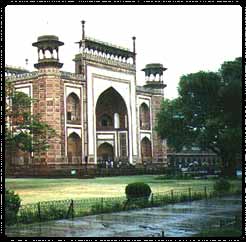 In this courtyard stand the main gateway to the Taj and its gardens, a massive portal that opens to the south. Detached gateways were long a traditional feature of Muslim architecture and could be found fronting tombs and mosques throughout the East. Symbolically to the Muslim, such an entrance way was the gate to paradise. Metaphysically, it represented the transition point between the outer world of the senses and the inner world of the spirit.
In this courtyard stand the main gateway to the Taj and its gardens, a massive portal that opens to the south. Detached gateways were long a traditional feature of Muslim architecture and could be found fronting tombs and mosques throughout the East. Symbolically to the Muslim, such an entrance way was the gate to paradise. Metaphysically, it represented the transition point between the outer world of the senses and the inner world of the spirit.
Structure
Made of red sandstone, this 150 ft. wide and nearly 100 ft. high, gateway consists of a lofty central arch with double storeyed wings on either side. Octagonal towers are attached to its corners which are surmounted by broad impressive open domed kiosks. The most important feature of the gateway however is the introduction of a series of eleven attached chhatris (umbrellas) with marble cupolas, flanked by pinnacles, above the central portal on the north and south sides. A heavy door at the base is made from eight different metals and studded with knobs. Inside are countless rooms with hallways that wind and divide in such apparent abandon that they seem intentionally built to confuse; perhaps they were, for they have remained unused for three centuries and their purpose has long confounded the experts. Within the archway of this majestic entrance, there is a large chamber with a vaulted roof.
Decoration
The gateway is richly embellished. Of particular note are the floral arabesques fashioned from gemstones and inlaid in while marble which decorate the spandrels of the arches. Also impressive are the inlaid black marble inscriptions that frame the central vaulted portal or iwan. These passages are excerpts from the Koran, which is considered by Muslims to be the word of God as revealed to Mohammed. It is here that Shah Jehan's calligraphers have performed an amazing optical trick : the size of the lettering that runs up and over the arch appears to be consistent from top to bottom. This illusion was created by gradually heightening the size of the letters as their distance from the eye increased; from the ground the dimensions seem the same at every point. This ingenious trompe l'oeil effect is used with equal success on the main doorway of the Taj itself. It is said that upon first beholding the Taj through this gateway it will look small and far away, as if built in three-quarter scale. This is another optical trick. As one approaches, the illusion turns into another illusion: the building begins to grow, and continues to grow until, when the base is reached, it looms colossal. The dome especially seems to expand as one comes near, almost as if it were being slowly inflated.
Purpose
 In this courtyard stand the main gateway to the Taj and its gardens, a massive portal that opens to the south. Detached gateways were long a traditional feature of Muslim architecture and could be found fronting tombs and mosques throughout the East. Symbolically to the Muslim, such an entrance way was the gate to paradise. Metaphysically, it represented the transition point between the outer world of the senses and the inner world of the spirit.
In this courtyard stand the main gateway to the Taj and its gardens, a massive portal that opens to the south. Detached gateways were long a traditional feature of Muslim architecture and could be found fronting tombs and mosques throughout the East. Symbolically to the Muslim, such an entrance way was the gate to paradise. Metaphysically, it represented the transition point between the outer world of the senses and the inner world of the spirit. Structure
Made of red sandstone, this 150 ft. wide and nearly 100 ft. high, gateway consists of a lofty central arch with double storeyed wings on either side. Octagonal towers are attached to its corners which are surmounted by broad impressive open domed kiosks. The most important feature of the gateway however is the introduction of a series of eleven attached chhatris (umbrellas) with marble cupolas, flanked by pinnacles, above the central portal on the north and south sides. A heavy door at the base is made from eight different metals and studded with knobs. Inside are countless rooms with hallways that wind and divide in such apparent abandon that they seem intentionally built to confuse; perhaps they were, for they have remained unused for three centuries and their purpose has long confounded the experts. Within the archway of this majestic entrance, there is a large chamber with a vaulted roof.
Decoration
The gateway is richly embellished. Of particular note are the floral arabesques fashioned from gemstones and inlaid in while marble which decorate the spandrels of the arches. Also impressive are the inlaid black marble inscriptions that frame the central vaulted portal or iwan. These passages are excerpts from the Koran, which is considered by Muslims to be the word of God as revealed to Mohammed. It is here that Shah Jehan's calligraphers have performed an amazing optical trick : the size of the lettering that runs up and over the arch appears to be consistent from top to bottom. This illusion was created by gradually heightening the size of the letters as their distance from the eye increased; from the ground the dimensions seem the same at every point. This ingenious trompe l'oeil effect is used with equal success on the main doorway of the Taj itself. It is said that upon first beholding the Taj through this gateway it will look small and far away, as if built in three-quarter scale. This is another optical trick. As one approaches, the illusion turns into another illusion: the building begins to grow, and continues to grow until, when the base is reached, it looms colossal. The dome especially seems to expand as one comes near, almost as if it were being slowly inflated.
Built by
shah jahan
taj mahal should be taken care off !!!
the article showing that we haveto take care of this moument
The Taj Mahal will collapse within five years unless urgent action is taken to shore up its foundations, campaigners have warned.
The 358-year-old marble mausoleum is India’s most famous tourist attraction, bringing four million visitors a year to the northern city of Agra.
But the river crucial to its survival is being blighted by pollution, industry and deforestation.

In danger: The Taj Mahal, near Agra in India. Experts have said it could be in danger of collapsing within five years because its wooden foundations are rotting
Campaigners believe the foundations have become brittle and are disintegrating.
Cracks appeared last year in parts of the tomb, and the four minarets which surround the monument are showing signs of tilting.
The Taj Mahal was built by Mogul emperor Shah Jahan, who was grief-stricken by the death of his wife Mumtaz Mahal in childbirth.
Its romantic image has attracted film stars and royalty, including Princess Diana, who posed in front of the building after the breakdown of her marriage to Prince Charles.
A campaign group of historians, environmentalists and politicians say time is running out to prevent a 'looming crisis'.

Architectural wonder: The 358-year-old tomb is built on mahogany post foundations sunk into wells fed by the nearby Yamuna River. That river has now run dry, and cracks appeared in the walls last year
Ramshankar Katheria, the MP for Agra who is leading the campaign, said: 'If the crisis is not tackled on a war-footing, the Taj Mahal will cave in between two and five years.
'The architectural wonder of the world is losing its shine, and if this persists the minarets may also collapse since the wooden foundation - beneath the wells - is rotting due to lack of water.
'No one has been allowed to go into the foundations for the last three decades. If everything is fine, what have they got to hide?'
Professor Ram Nath, a historian who is one of the world's leading authorities on the Taj, said: 'The Taj stands just on the edge of the river Yamuna which has now dried up.
'This was never anticipated by its builders. The river is a constituent of its architectural design and if the river dies, the Taj cannot survive.'

Attraction: The Taj Mahal, built by Mogul emperor Shah Jahan after the death of his wife Mumtaz Mahal in childbirth, gets around four million visitors a year
The Yamuna River has fallen victim to India's soaring growth.
Large numbers of businesses draw water from the Yamuna upstream of the Taj.
Pollution has increased as trees have been cut down to make way for new roads.
The trees also protected the city from the worst effects of regular dust storms which now blow over the Taj unimpeded.
Mr Katheria said: 'The Taj has been enveloped by a smokescreen of dust for the past few years.
'Every year, the water level is coming down by five feet, raising fears of turning the entire area barren.
'Besides, there is an acute shortage of drinking water in Agra. Around 70 per cent of the population is drinking impure water, and consequently suffering from several health hazards.'
The Taj is built on a raised platform on top of a hillock, which is based on wells underneath.
The four 40ft high minarets balance the platform, and are designed to tilt slightly outwards, to prevent them crashing on top of the tomb in an earthquake.
Mr Katheria said around £71million is needed to construct a barrage on the river.
Environmental campaigners also believe a tree-planting campaign and a water pipeline may improve the situation.
The sinking water level is also affecting India's capital, New Delhi, which is at risk of suffering water shortages.
The Indian government has set up body to deal with the Taj Mahal's preservation.
Officials connected with eight projects say the national and state governments are now working together to deal with the issue.
BB Awasthi, regional officer of the Uttar Pradesh Pollution Control Board, said: 'These projects have been held up since 2003 for want of funds.'
He said he expected the projects 'would receive top priority treatme
Read more: http://www.dailymail.co.uk/news/article-2045183/Taj-Mahal-collapse-5-years-wooden-foundations-rotting.html#ixzz2kdloD5gR
Follow us: @MailOnline on Twitter | DailyMail on Facebook
we should not promote people chewing tobacco and spread knowledge and put banners all around and emphasize on saving the monument.
After
Before
The Taj Mahal (/ˈtɑːdʒ məˈhɑːl/ often /ˈtɑːʒ/;[2] Hindi: ताज महल, from Persian/Urdu: تاج محل "crown of palaces", pronounced [ˈt̪aːdʒ mɛˈɦɛl]; also "the Taj"[3]) is a white marble mausoleum located in Agra, Uttar Pradesh, India. It was built by Mughal emperor Shah Jahan in memory of his third wife, Mumtaz Mahal. The Taj Mahal is widely recognized as "the jewel of Muslim art in India and one of the universally admired masterpieces of the world's heritage".[4]
Taj Mahal is regarded by many as the finest example of Mughal architecture, a style that combines elements from Persian and Indian architectural styles.[5][6]
In 1983, the Taj Mahal became a UNESCO World Heritage Site. While the white domed marble mausoleum is the most familiar component of the Taj Mahal, it is actually an integrated complex of structures. The construction began around 1632 and was completed around 1653, employing thousands of artisans and craftsmen.[7] The construction of the Taj Mahal was entrusted to a board of architects under imperial supervision, including Abd ul-Karim Ma'mur Khan, Makramat Khan, and Ustad Ahmad Lahauri.[8][9] Lahauri[10] is generally considered to be the principal designer
Origin and inspiration
Main article: Origins and architecture of the Taj Mahal
In 1631, Shah Jahan, emperor during the Mughal empire's period of greatest prosperity, was grief-stricken when his third wife, Mumtaz Mahal, a Persianprincess, died during the birth of their 14th child, Gauhara Begum.[13] Construction of the Taj Mahal began in 1632.[14] The court chronicles of Shah Jahan's grief illustrate the love story traditionally held as an inspiration for Taj Mahal.[15][16] The principal mausoleum was completed in 1648 and the surrounding buildings and garden were finished five years later. Emperor Shah Jahan himself described the Taj in these words:[17]Should guilty seek asylum here,
Like one pardoned, he becomes free from sin.
Should a sinner make his way to this mansion,
All his past sins are to be washed away.
The sight of this mansion creates sorrowing sighs;
And the sun and the moon shed tears from their eyes.
In this world this edifice has been made;
To display thereby the creator's glory.
The Taj Mahal incorporates and expands on design traditions of Persian architecture and earlier Mughal architecture. Specific inspiration came from successful Timurid and Mughal buildings including; the Gur-e Amir (the tomb of Timur, progenitor of the Mughal dynasty, in Samarkand),[18]Humayun's Tomb, Itmad-Ud-Daulah's Tomb (sometimes called the Baby Taj), and Shah Jahan's own Jama Masjid in Delhi. While earlier Mughal buildings were primarily constructed of red sandstone, Shah Jahan promoted the use of white marble inlaid with semi-precious stones, and buildings under his patronage reached new levels of refinement.[19]
Tomb
The tomb is the central focus of the entire complex of the Taj Mahal. This large, white marble structure stands on a square plinth and consists of a symmetrical building with an iwan (an arch-shaped doorway) topped by a large dome and finial. Like most Mughal tombs, the basic elements are Persian in origin.
The base structure is essentially a large, multi-chambered cube with chamfered corners, forming an unequal octagon that is approximately 55 metres (180 ft) on each of the four long sides. On each of these sides, a huge pishtaq, or vaulted archway, frames the iwan with two similarly shaped, arched balconies stacked on either side. This motif of stacked pishtaqs is replicated on the chamfered corner areas, making the design completely symmetrical on all sides of the building. Four minarets frame the tomb, one at each corner of the plinth facing the chamfered corners. The main chamber houses the false sarcophagi of Mumtaz Mahal and Shah Jahan; the actual graves are at a lower level.
The marble dome that surmounts the tomb is the most spectacular feature. Its height of around 35 metres (115 ft) is about the same as the length of the base, and is accentuated as it sits on a cylindrical "drum" which is roughly 7 metres (23 ft) high. Because of its shape, the dome is often called an onion dome or amrud (guava dome). The top is decorated with a lotus design, which also serves to accentuate its height. The shape of the dome is emphasised by four smaller domed chattris (kiosks) placed at its corners, which replicate the onion shape of the main dome. Their columned bases open through the roof of the tomb and provide light to the interior. Tall decorative spires (guldastas) extend from edges of base walls, and provide visual emphasis to the height of the dome. The lotus motif is repeated on both the chattris and guldastas. The dome and chattris are topped by a gilded finial, which mixes traditional Persian and Hindustani decorative elements.
The main finial was originally made of gold but was replaced by a copy made of gilded bronze in the early 19th century. This feature provides a clear example of integration of traditional Persian and Hindu decorative elements. The finial is topped by a moon, a typical Islamic motif whose horns point heavenward. Because of its placement on the main spire, the horns of the moon and the finial point combine to create a trident shape, reminiscent of traditional Hindu symbols of Shiva.[7]
The minarets, which are each more than 40 metres (130 ft) tall, display the designer's penchant for symmetry. They were designed as working minarets—a traditional element of mosques, used by the muezzin to call the Islamic faithful to prayer. Each minaret is effectively divided into three equal parts by two working balconies that ring the tower. At the top of the tower is a final balcony surmounted by a chattri that mirrors the design of those on the tomb. The chattris all share the same decorative elements of a lotus design topped by a gilded finial. The minarets were constructed slightly outside of the plinth so that, in the event of collapse, (a typical occurrence with many tall constructions of the period) the material from the towers would tend to fall away from the tomb.
The map where it is situated
Mumtaj Mahal
The layout
| Taj Mahal تاج محل ताज महल | |
|---|---|

Southern view of the Taj Mahal.
| |
| Location | Agra, Uttar Pradesh, India |
| Coordinates | 27.174799°N 78.042111°E |
| Elevation | 171 m (561 ft) |
| Built | 1632–1653[1] |
| Architect | Ustad Ahmad Lahauri |
| Architectural style(s) | Mughal architecture |
| Visitation | More than 3 million (in 2003) |
| Type | Cultural |
| Criteria | i |
| Designated | 1983 (7th session) |
| Reference No. | 252 |
| State Party | India |
| Region | Asia-PacificShah jahan |
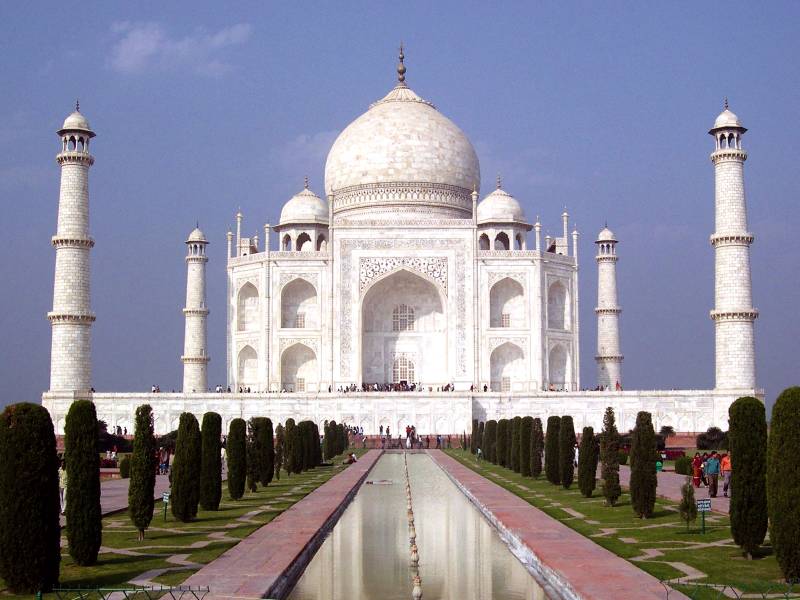





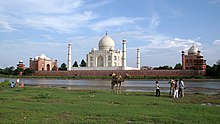
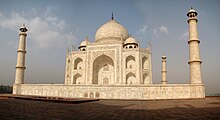
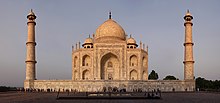


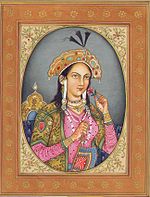



No comments:
Post a Comment